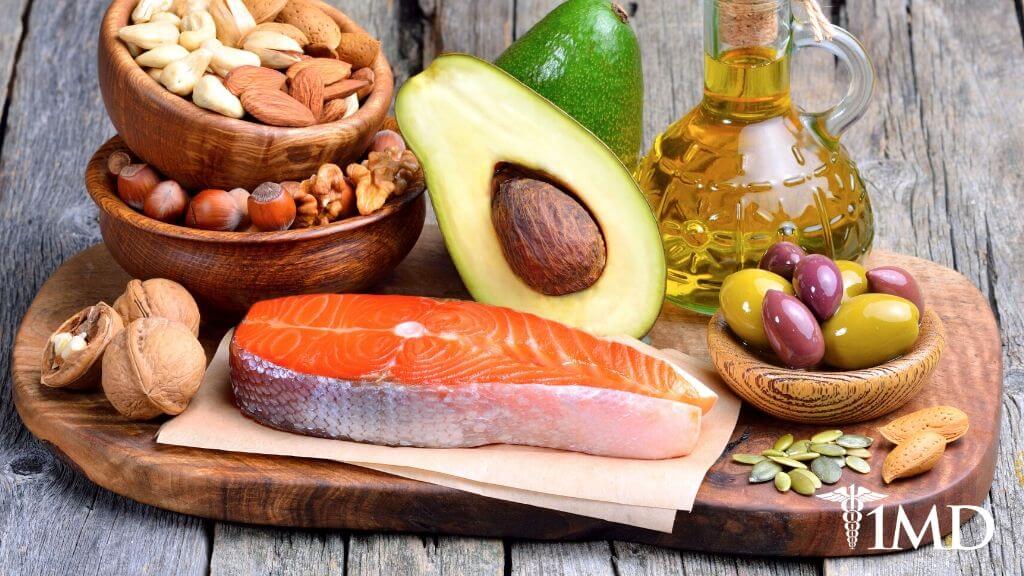Meet the Omegas: 3, 5, 6, 7, and 9
7 minute read
Not only are there different fats out there, of which some are good, and some are bad, but there are also different types within the fat groups. It can take a while to learn about saturated and monounsaturated, trans fats, and fatty acids, but understanding the differences can benefit your health.
The family of omega fatty acids is essential to your health, so you should know what exactly they are and why you need them.
What Are Fatty Acids?
Fatty acids contain a chain of carbon atoms linked by single or double bonds. When the bonds are single, it is considered to be saturated because there are no spare bonds.
When one or more double bonds are present, the fatty acid is unsaturated. The number of double bonds and their position in the chain determine the flexibility of the acid.
Saturated fats tend to be solid at room temperature, whereas unsaturated fats melt into oils.

One double bond in the chain denotes the molecule as monounsaturated; two or more bonds make a polyunsaturated fatty acid. The position of the first double bond in relation to the omega (methyl) end of the chain allows you to further classify the fatty acids.
♦ When the first bond involves the third carbon atom, you have an omega-3 fatty acid.
♦ When the bond involves the sixth carbon atom, you get an omega-6 fatty acid.
♦ A bond on the seventh carbon is an omega-7 fatty acid.
♦ A bond on the ninth carbon gives you an omega-9 fatty acid.
Triglycerides are the fats you typically find in your diet and your body. These fats contain a glycerol backbone linked to three fatty acid chains.
Because the chains can be both saturated or unsaturated, the fats in your diet and those stored in your body are a blend of fats.
Animal-based foods typically have more saturated fats than vegetable foods. The type of fat found in animal foods will depend upon what they have been fed and their genetic makeup.
Getting Down to the Essentials
The cells in your body can make monounsaturated fatty acids. Most polyunsaturated fatty acids from the fats you get in your diet.
When it comes to omega fatty acids, you can only make these from other omega fatty acids, thus making them essential. Omega-3 and omega-6 fatty acids are both essential and need to be balanced within our diet to maintain optimal health.

Our ancestors lived on diets that had omega-6 to omega-3 ratios of 2:1, and diets today typically see the ration closer to 10:1.
The increased consumption of vegetable oils and processed foods cause this ratio to be unhealthy. There is not enough intake of omega-3-rich foods, such as nuts and oily fish, so the balance gets really out of whack.
This omega imbalance has been linked to increased risk of inflammatory-related diseases like asthma, eczema, and coronary heart disease. To get a healthier balance and optimal health, you need to increase omega-3 intake and cut back on omega-6 foods.
Eat more oily fish, wild game meat, grass-fed beef, omega-3 enriched eggs, and take omega-3 oil supplements.
Avoid vegetable oils, such as sunflower oil or corn oil, margarine, and ready-made cakes, sweets, and pastries.
The Trouble With Omega-3 & -6 Imbalance
The two omega fatty acids that are considered essential are linoleic acid, which is an omega-6 fatty acid, and alpha-linolenic acid (an omega-3). These can be used as building blocks to make the other omega fatty acids your body needs.
When your diet is lacking in these oils or you are making too few long-chain omega-3s, your body makes do with whatever is available. You end up using saturated fatty acids and harmful trans fats in cellular processes.
The fatty acids created are less flexible, which reduces the elasticity of the artery walls and the speed at which messages are passed between nerve cells in the brain. Your body starts to suffer from an essential fatty acid deficiency, causing symptoms such as:
♦ Dry, scaly, and itchy skin
♦ Soft or brittle nails
♦ Dull, straw-like hair
♦ Asthma or hayfever
♦ Visual difficulties, light sensitivity
♦ Impaired immunity
♦ Sleep problems
♦ Emotional sensitivity

Not only do you want to keep the omega-3 to omega-6 ratio balanced, but you also need to make sure your overall fat intake promotes health. Excess saturated fats are linked to obesity, heart disease and can raise your cholesterol levels.
| Related: The DNA of Krill Oil: The Facts Behind EPA & DHA |
It is therefore advised to keep the intake of these fats low. Omega-7 and omega-9 fatty acids are monounsaturated fats and are found in almonds, hazelnuts, avocado, and olive oil.
Eating monounsaturated fats, like omega-7s and omega-9s, help your cholesterol. These fats are metabolized in a way that lowers the LDL (bad) cholesterol but not the HDL (good) cholesterol.
A diet high in monounsaturated fats can help protect your heart as well as reduce your risk of type-2 diabetes, atherosclerosis, high blood pressure, and stroke. These monounsaturated fats are a prominent part of the Mediterranean diet, which is known globally for its health benefits.
Leave the Trans Fats Behind
Polyunsaturated fatty acids are typically oils at room temperature, but they can be converted to semi-solid spreads artificially. Adding extra hydrogen atoms converts the double bonds to single bonds, leaving these once flexible fats as twisted, rigid fats known as trans-fatty acids.
This hydrogenation process is common in the processing of many of the harmful fat items we eat today.

The trans fats are dangerous because they increase the rigidity of cell membranes and increase the levels of bad cholesterol in your blood. They are also associated with weight gain, poor glucose control, and increased risk of inflammatory-related diseases.
Trans fats are also known to increase your risk for specific cancers, namely breast and prostate cancers. The trans fats found in dairy products are structurally different from those that are artificially created and are not known to have the same damaging effects on your health.
Many kinds of margarine and spreads have been reformulated to reduce the trans fat content in light of the health concerns, but it is still recommended to avoid them if possible. A little butter or margarine in moderation will not hurt you.
The Bottom Line
The best advice to promoting overall health is to eat a variety of foods and to moderate intake of those foods that may be of concern. Always check the labels of your foods to evaluate fat content, specifically the type of fat.
Knowing which specific fat you are eating can help to keep omega oils fatty acids in balance, keep unhealthy fats to a minimum, and keep your health in optimal condition.












